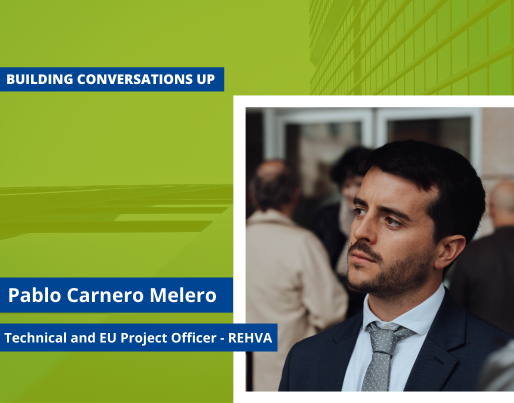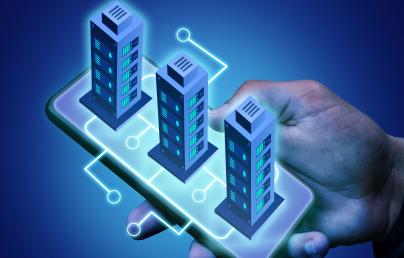Pablo Carnero Melero: “When it comes to decarbonisation and smartness in buildings, the whole is more than the sum of the parts”

Pablo Carnero Melero: “When it comes to decarbonisation and smartness in buildings, the whole is more than the sum of the parts”
Introduction
Pablo has been working as a consultant for REHVA since February 2023, balancing the role of Technical and EU Project Officer with the secretariat of the Technical Research Committee. His research and practice have traditionally been linked to energy performance and decarbonisation of existing buildings, and more recently integrating the issue of building smartness. Beyond his technical background, he is passionate about the social and economic aspect of energy access and use. He has collaborated in the past with local initiatives in the field of energy poverty and has been involved in educational programs for the upskilling of architects in dwelling energy renovation. He is based in Valencia (Spain).
BUILD UP (BUP): What are smart buildings?
PABLO CARNERO MELERO (PCM): A building is said to be smart when it can sense, interpret, communicate, and actively respond in an efficient manner to changing conditions in relation to the operation of technical building systems, the external environment, and demands from building occupants. This is the definition from the Commission Delegated Regulation 2020/2155. The Smart Readiness Indicator (SRI) is the common European scheme to rate the smartness of buildings and building units. In short, the smartness of a building is related to the capabilities of its automation and control systems.
BUP: Please explain the importance of smart buildings in decarbonising the EU building stock and making buildings more energy efficient.
PCM: In a nutshell, smart technologies improve the operational energy performance of any building and amplify the positive impact of energy efficient renovations. Imagine a typical building from the mid-twentieth century. There is an old fossil fuel boiler for space heating, with high-temperature water radiators. The operation of the technical building systems is manual, completely relying on human intervention. As a result, oftentimes the boiler is heating up the water more than needed, the radiators are on in unoccupied rooms, etc. Now imagine that a thermostat is installed to adjust the water temperature of the radiators to the outdoor temperature or to the indoor demand. It is estimated that up to 15% of the baseline heating energy consumption could be reduced.
Let’s say that the building is renovated and a heat pump with thermal energy storage and low-temperature emitters replace the old and inefficient heating system. Now, the automation and control possibilities include heating up the water during the day, usually leveraging greater renewable share and lower prices in the electricity grid and using it during the night! This is just an example with the heating service, but the rationale holds true for domestic hot water, space cooling, lighting, and any other building energy service.
”Smart technologies improve the operational energy performance of any building
and amplify the positive impact of energy efficient renovations”
BUP: How can smart buildings enhance occupants´ comfort and wellbeing?
PCM: Smart technologies enable occupants to manage the building according to their needs. For example, the indoor air quality can be ensured through automatic operation of the mechanical ventilation system or motorised windows. Also, the operation of the heating or cooling system can be adjusted to facilitate that a room is conditioned before the occupant enters the building, minimising the thermal discomfort. The lighting intensity can be adapted depending on the activity being performed in each space.
BUP: What are the challenges associated with retrofitting existing buildings to incorporate smart technologies?
PCM: The challenges associated to incorporate smart technologies in existing buildings are like those of any energy efficiency renovation. This includes the constraints imposed by the legacy equipment. However, this can also be regarded as an opportunity because the added value that smart technologies can bring to existing buildings exponentially grow when coupled with interventions that consider demand electrification, on-site renewables, and energy storage. When it comes to decarbonisation and smartness in buildings, the whole is more than the sum of the parts.
“Smart technologies enable occupants to manage the building according to their needs”
BUP: Please present some projects about smart building and technologies you are, or were, involved with, and give a short summary of their results and wider impact.
PCM: Last year, under the LIFE-2021-CET-SMARTREADY topic, four projects were funded aiming at creating the conditions for a global improvement of the smartness of the European building stock, leveraging the Smart Readiness Indicator (SRI). REHVA is partner in two of the four, SRI2market and Smart Square. In general, I’d like to emphasise the effort put by the European funded projects in facilitating the testing and implementation of the SRI scheme at the national level through the development of supporting tools, training materials, stakeholder engagement guidance, etc. In particular, I’d remark that the SRI Observatory is the site to stay up to date on the latest SRI policy developments at the EU level, to track and compare national implementation status, and to find out about the most relevant research developments in the field of building smartness.
BUP: How might advancements in artificial intelligence (AI) shape the future capabilities of smart building systems?
PCM: Artificial intelligence may support higher functionality levels of smart building systems in various ways, many of which might not be fully grasped today. From the technical perspective, it has the potential to holistically optimise building control, thanks to the immense capabilities in dealing with large and various datasets. In addition, it may significantly support predictive maintenance by inferring unperceived patterns in technical building system operation. Nevertheless, there are ethical issues when it comes to personal data ownership and protection that shall be carefully considered.


